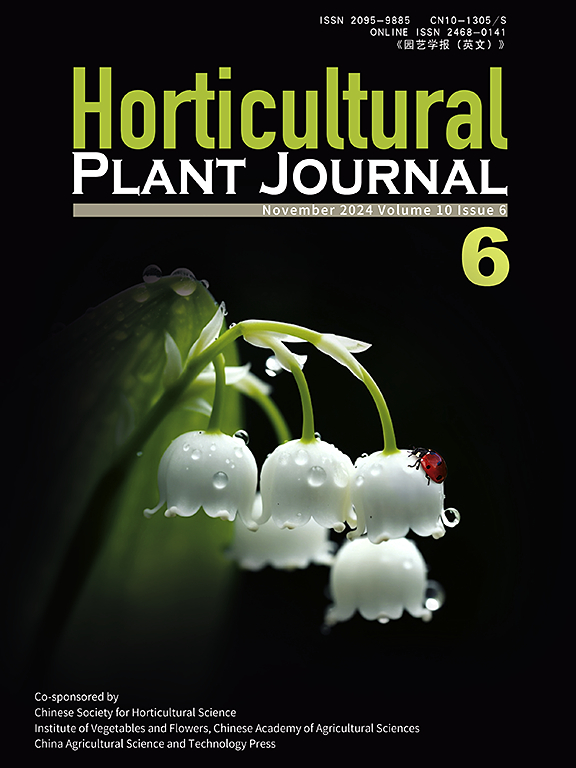通过全基因组关联研究鉴定茶树二羟基儿茶素积累调控关键基因CsRNF144
IF 6.2
1区 农林科学
Q1 HORTICULTURE
引用次数: 0
摘要
茶是一种广泛消费的营养饮料,富含氨基酸、咖啡因和儿茶素,这些都有助于茶的口感和促进健康的特性。虽然很多研究都集中在对红茶品质至关重要的儿茶素上,但二羟基儿茶素却很少受到关注。调控这些特异性积累的遗传机制仍需要更好地了解,这在旨在提高茶叶品质的育种策略上造成了空白。为了解决这一问题,本研究对3种茶树(茶树茶、茶树茶和茶树茶)的329份茶叶材料进行了全基因组关联研究(GWAS),发现二羟基儿茶素含量存在显著差异。发现44个显著snp和5个候选基因。功能分析,包括烟草中的过表达和反义寡核苷酸(AsODN)实验,表明CsRNF144在这一过程中起关键作用。CsRNF144的过表达导致双羟基儿茶素含量增加,而AsODN的干扰显著降低了双羟基儿茶素水平,证实了该基因参与了高效积累。这些发现确定了一种与茶中二羟基儿茶素有效积累有关的基因,为今后提高茶叶风味的育种提供了理论基础。此外,研究结果还强调了保护和开发野生茶种质的重要性,这些种质可作为改良栽培品种的宝贵遗传资源。本文章由计算机程序翻译,如有差异,请以英文原文为准。
Identification of CsRNF144 as a key gene regulating di-hydroxy catechins accumulation in Camellia tachangensis through genome-wide association studies
Tea is a widely consumed and nutritious beverage, rich in amino acids, caffeine, and catechins, which contribute to its taste and health-promoting properties. While much research has focused on catechins, which are essential for black tea quality, di-hydroxy catechins have received less attention. The genetic mechanisms that regulate the accumulation of these specific still need to be better understood, creating a gap in breeding strategies aimed at enhancing tea quality. This study conducted a genome-wide association study (GWAS) on 329 tea accessions from three species (Camellia tachangensis F. C. Zhang, Camellia sinensis var. sinensis , and Camellia gymnogyna Chang) to address this gap, identifying significant variation in di-hydroxy catechin content. C. tachangensis displayed notably higher di-hydroxy catechin levels, and 44 significant SNPs and 5 candidate genes were identified. Functional analysis, including overexpression in tobacco and antisense oligodeoxynucleotide (AsODN) experiments, showed that CsRNF144 plays a critical role in this process. Overexpression of CsRNF144 led to increased di-hydroxy catechin content, while AsODN interference in C. tachangensis significantly reduced di-hydroxy catechin levels, confirming the gene’s involvement in efficient accumulation. These findings identified a gene involved in the efficient accumulation of di-hydroxy catechins in C. tachangensis and provide a theoretical foundation for future tea breeding programs aimed at enhancing flavor. Additionally, the results emphasize the importance of protecting and developing wild tea accessions, which could serve as valuable genetic resources for improving cultivated varieties.
求助全文
通过发布文献求助,成功后即可免费获取论文全文。
去求助
来源期刊

Horticultural Plant Journal
Environmental Science-Ecology
CiteScore
9.60
自引率
14.00%
发文量
293
审稿时长
33 weeks
期刊介绍:
Horticultural Plant Journal (HPJ) is an OPEN ACCESS international journal. HPJ publishes research related to all horticultural plants, including fruits, vegetables, ornamental plants, tea plants, and medicinal plants, etc. The journal covers all aspects of horticultural crop sciences, including germplasm resources, genetics and breeding, tillage and cultivation, physiology and biochemistry, ecology, genomics, biotechnology, plant protection, postharvest processing, etc. Article types include Original research papers, Reviews, and Short communications.
 求助内容:
求助内容: 应助结果提醒方式:
应助结果提醒方式:


